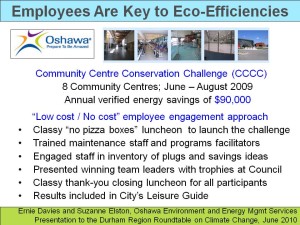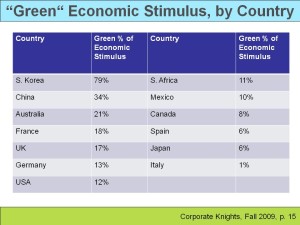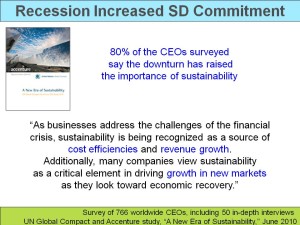3 More Ways to Reframe Sustainability for CEOs
Short Term Sustainability-based Strategies for Smart CEOs

As sustainability champions, we need to respect executives’ current priorities and help them save face if they “have no time right now” for sustainability. We need to find out what executives do have time for. Then, reframe our proposals as enabling strategies to help them address their urgent, pressing challenges— rather than as one more goal to worry about. Agree with their priorities. Meet them where they are. Honor their terminology and mindset; and suggest how sustainability-based strategies will help to achieve their current goals.
In my June 22, 2010 blog, I outlined how sustainability-related strategies address five long-term challenges which are anticipated by CEOs within the next five to ten years. There is a misperception though: that sustainability strategies only apply to long-term goals and aren’t much help with short-term, recession-driven pressures on the bottom line. That’s wrong. Here are three, near-term challenges faced by CEOs, and the accompanying sustainability-based strategies that can help each one:
1. Protect cash flow
When credit is tight and revenue is slow, cash flow is king. Normally, that means cutting expenses—and too often, that means personnel layoffs. An alternative is to “layoff” energy, water, materials, and waste handling expenses. These are the low-hanging fruit of eco-efficiencies and can only be fully realized quickly with the creative help of engaged employees. As this slide about the Oshawa CCCC energy saving challenge shows, eco-efficiency savings can be fast and permanent if the staff’s help is respectfully enabled, valued, and recognized. This saves money quickly. Saving the world is a co-benefit.
2. Capitalize on economic stimulus funding
Depending on the countries in which your company has its operations, customers, or suppliers, the “green” part of the economic stimulus in those jurisdictions can be a significant, direct or indirect help. Ferret them out and capitalize on government help with retrofits, renewable energy projects, and clean technologies. If there is free money available, exploit it or help customers and suppliers tap into it. Your banker will be happy. So will the environment.
3. Grow revenue streams
Expand the services part of your business to compliment product offerings. Try leasing products instead of selling them, in order to generate steady, predictable cash flows. Appeal to a growing consumer segment with “green” products. Focus on local markets to protect against unpredictable global markets and reduce transportation costs. Build new collaborative partnerships to expand your reach into new markets. Ask your employees for revenue-generating ideas. Ask your customers. Ask Mother Nature by exploring biomimicry product design possibilities.
Smart CEOs recognize that sustainability strategies are relevant during a recession. In Boston College’s October 2009 report, “2009 State of Corporate Citizenship in the U.S.,” 54% of business leaders say that attention to corporate citizenship efforts is even more important in a recession. Recently, this percentage grew, as shown in the June 2010 UN Global Compact-Accenture report, “A New Era of Sustainability,” referenced in the adjacent slide. Eighty percent of the CEOs surveyed here say that the economic downturn has raised the importance of sustainability strategies. Why? Because corporate social responsibly (CSR) approaches help to save expenses, capitalize on “green” economic stimulus funds, and grow revenue. They are good for the company. They’re also good for society.
I used to be focused on motivations. I wanted companies to do the right things for the right reasons. Now, my sense of urgency about sustainability issues has refocused me: I want companies to do the right things, regardless of their motives. I have adopted a “whatever works” mindset. As Thomas Friedman said in a December 19, 2009 interview in Grist: “The way you get big change is by getting the big players to do the right things for the wrong reasons. If you wait for everyone to do the right thing for the right reason, you’re going to be waiting a long, long time.”
We can’t wait a long, long time. We need to reframe sustainability strategies as business strategies. We need to make them relevant to CEOs’ short- and long-term priorities. We need to get on with it. We can help them evolve to the “right” motivations later on.
Bob
Please feel free to add your comments and questions using the Leave a Comment link below.
The slides will be available to subscribers in the next release of the Master Slide Set.







Comments are closed.